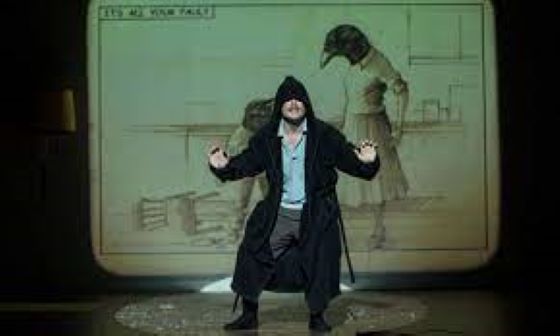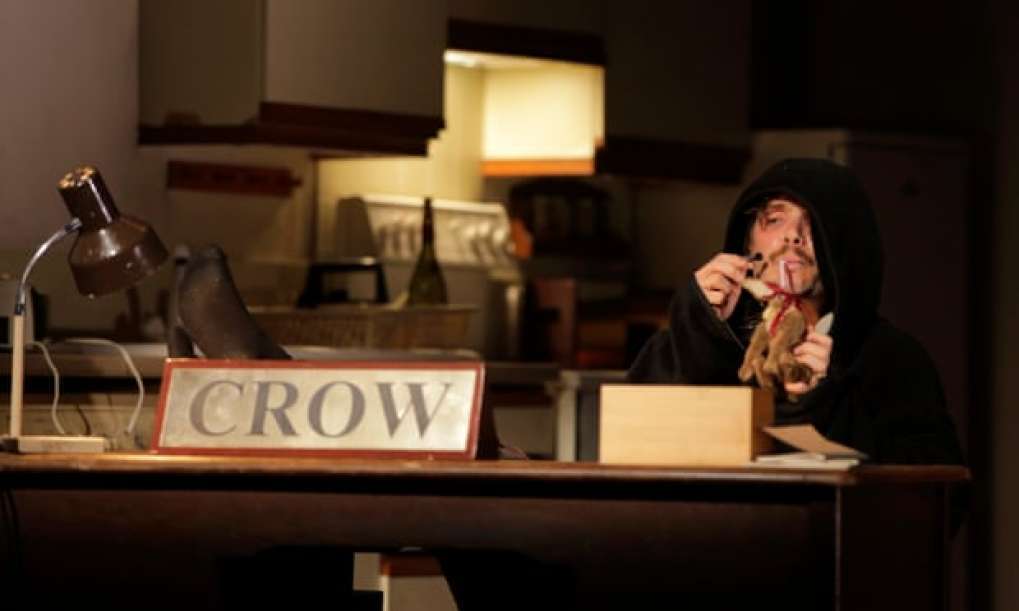Animal Study as Creative Process
- Written by Christina Kapadocha
- Published in BLOG
- 0 comments
- Read 535 times
- font size decrease font size increase font size
The image I choose for this post of our Animal Study (AS) practice is from the Complicité's production Grief is the Thing with Feathers (2018-2019) starring Cillian Murphy. In my understanding, the lead character in the show, moving in-between a crow and a grieving man, is a great example of how we could move in-between the animal and the human character (either text-based or devised) in acting.
For this practice, I would like for us to use AS as ground towards a broader understanding of our work as a creative methodology which you might find helpful for the further development of your own work as actor-creators, including but not limited to the shaping of your devised projects and characters.
For your preparation:
Study two brief movement sequences of your animal that you could revisit as a 'movement score'. From the situations we have been exploring in T2, choose one sequence from your animal's 'happy place' and one from a shifting situation in response to the behaviour of your animal i.e. response to danger, attack or defense. Try to choose a set of distinctive/'performative' expressions. Your animal's social behaviour such as mating call physicality and voicing could give you interesting ground. Videos that show the animals' physicality in slow motion (if available) could be particularly useful for this task.
Each sequence develops upon shorter movement phrases. Try to focus on the beginning-middle-end of the sequence so you will find the movement phrases within each section with attention to the detail. One section may have more than 1 phrases, depending on each animal, the chosen situation and how much you wish to evolve the sequence. For instance, for a yak, one of the most 'performative' sequences could be inspired by a 'horn battle' and a solo piece could go like that:
beginning section: head movement while the rest of the body stays still and grounded
middle section: dynamic shift into a 'horn' battle as if another male yak is present
end section: return to my personal space and gradually releasing the 'memory' of the battle
During the practice you are going to have time to revisit the chosen sequences through video material or breaking down notes. You don't have to practise the sequence in advance but you need to know what material you aim at developing so we don't lose productive time during the class. You should also be able to warm up towards the embodiment of your chosen animal considering their physicality and movements.
Planning your movement sequence:
Dynamics and time are very significant. Time is quite simple: is my animal generally slow of fast, which movements in the sequence are faster, which are slower etc. As for the dynamics, think of them more as movement qualities that can 'embellish' the movement score (i.e. smooth and soft or sharp and percussive, strong and loud or weak/quiet/gentle). For instance, in the example of the sequence above there can be a lot of contrast between smooth and sharp, strong and gentle, slow and fast dynamics.
Prepare your costume: Based on the surface of each animal's body, have available pieces of clothing that could help you getting closer to each animal's 'skin' and physicality. Try not to think of a costume in order to dress up like the animal and more clothes that resemble the animal's surface that could also lead you to a costume for the devised human character. Try to have available several items because we can never tell what will actually respond to the embodied process. You could experiment with make up as well if you would like to.
For instance, in the Grief is the Thing with Feathers, the actor was using a black robe that with simple moves (i.e. putting on and taking off the hoodie) gave him the opportunity to play with the animal or the human version inspired by the animal.

The overall structure in our Animal Study guidance:
AS in our work, apart from the movement patterns, basically applies the work we did in Term 1. And based on this structure I guide you through the following:
- the animal's weight/'size' and centre of gravity
- the animal's structure/shape (posture/stance) and articulation (where there is restriction of movement, where there is space for movement, from where actually the movement starts)
- the animal's 'muscle costume' beginning from the facial expression (we call this the animal's 'mask') and how this affects the rest of my body
- the animal's 'skin costume' (the surface of their bodies, i.e. fur, feathers, a different sort of skin etc. including "extensions" like tails, beaks etc.), how this affects their physical expression and how they interact with their natural environment
- the animal's sensory behaviour (touch, hearing, vision, smell), which is their 'dominant' sense
- the animal's breathing and how this relates with rhythm and dynamics
- the animal's vocal centre (head-chest-pelvis) and how this connects with physicality
- and finally, through all the above the animal's personality and social behaviour
I don't always have to follow all the above, just set the task in my mind before I begin my study: i.e. now I will study the animal's structure/shape as if I'm doing an Xray and I can see the animal's skeletal foundation. And then based on my observations other prompts may come up such as attention to the weight/centre of gravity.
Revisiting our creative methodology:
At this phase of our practice, you may wish to revise the 6 practical steps of our movement-based creative methodology. I explain it here more in relation to the specific task but, as we have discussed, you could actually apply it in any creative context. Depending on the nature of the project you could reverse the order of the steps:
- I concentrate – ‘arrive’: I warm-up my physicality (body) and focus (mind) in order to get ready for a specific study
- I see – visualise: I receive external information on my creative study. For instance, for this task I watch videos on my animal
- I move – physicalise: I explore the first ‘meeting’ between my own physicality and the new movement structures
- I embody - somatise: I release my focus on technical aspects and I allow the development of fluid inner-outer connection
- I reflect – integrate: I reflect upon the movements-moments that ‘work’ for me and the nature of my study
- I shape – create: I put my choices together and I compose a ‘movement score’ or 'block' phrases I could repeat
Hope the above helps and as always very much looking forward!
Take care,
Christina

